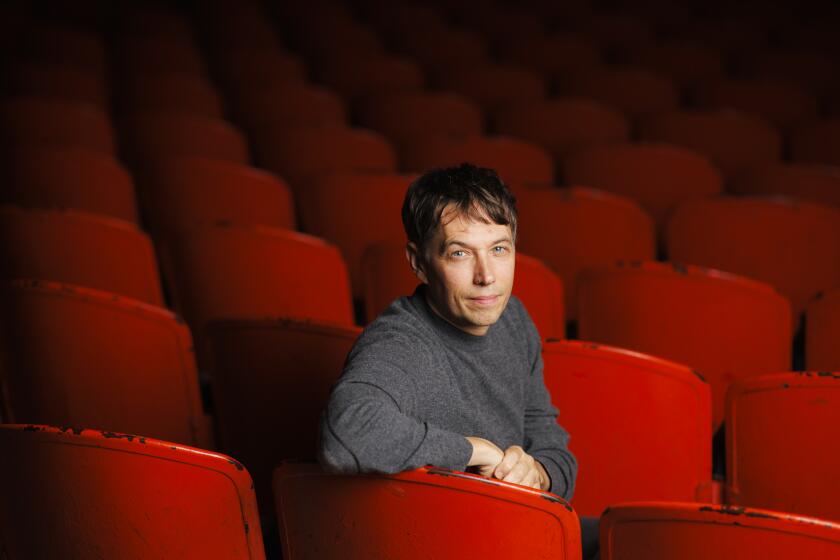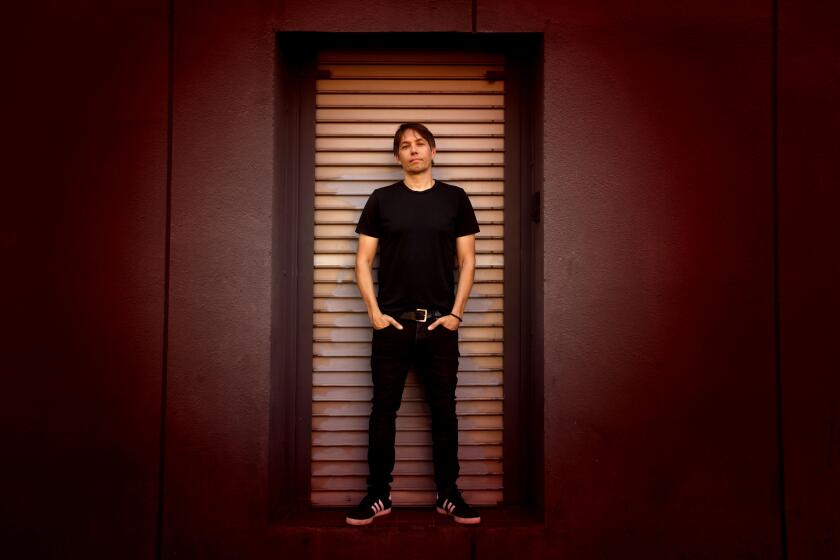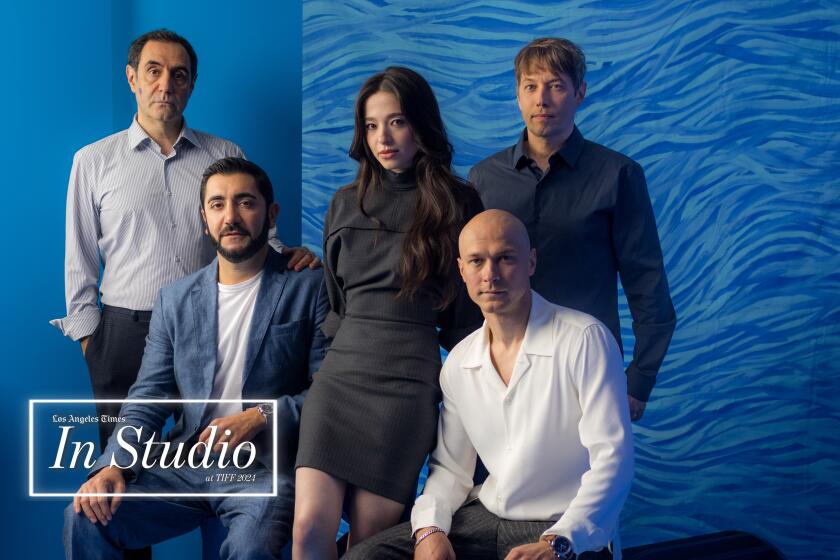
- Share via
Have you ever seen a photo of someone you’ve known for years that makes you change how you see them?
I’m looking at an image of filmmaker Sean Baker taken shortly after his open-hearted, screwball adventure “Anora” won the Palme d’Or, the Cannes Film Festival’s top prize, an award that Baker never in a million years dreamed he’d ever win. Posing with the Palme, Baker doesn’t look merely happy. Joy radiates from every fiber of his being. It’s the equivalent of Freddie Freeman dropping his bat after hitting that grand slam home run in Game 1 of the World Series. He’s in the moment, but he’s almost out of his body.
Part of that came from the convergence of circumstances onstage that day at the Lumière. Baker had just watched Francis Ford Coppola present George Lucas with an honorary Palme d’Or, something that threw Baker for a loop because those two filmmakers loomed large in his youth. But as he’s listening to Lucas, he’s also processing the fact that, by process of elimination, he thinks his movie might have just won the festival. Which it did.
So now Baker is pulling out a speech that he scratched out on a piece of paper an hour before the ceremony, something he put together so hastily that he still calls it his “junior high speech.”
Director Sean Baker loves Los Angeles moviegoing. We interviewed him at Gardena Cinema about ‘Anora,’ his brassy romantic comedy that should be a breakout.
“And Lucas was on my right watching me deliver it, which was more than a little nerve-racking,” Baker says. “And then we were taking photos, and I’m standing next to him and I thought, ‘OK. I have to say something. I have to tell him something. What am I going to say?’ And I told him I made ‘Space Wars’ in 1978 when I was 7 years old. And I hope he doesn’t sue me.”

Mikey Madison, who plays “Anora’s” title character, a Brooklyn stripper who meets and marries the feckless son of a Russian oligarch, has never heard this story.
“Do you think the tape still exists?” she asks of Baker’s Super 8 film. “Because I need to see this.”
“I’m sure it’s just ‘Star Wars’ toys flying around against the star field,” Baker says. “And I’m probably playing Luke Skywalker, and I think my sister was probably Princess Leia.”
We’re sitting in what passes for a greenroom at the AMC Century City 15, where Madison is signing a thick stack of “Anora” posters, asking me how old I was when I started toying with my signature. Hers — a couple of capital Ms, bracketed by a heart — seems perfectly fine, and I tell her to keep it for now.
We’re in between a rolling set of Q&As for the film, which has taken in more than $10 million in U.S. theaters and inspired a level of devotion that Baker has never seen with any of his previous movies. Take, for instance, the woman seated in the front row wearing a plum fur coat and red scarf, one of Madison’s signature looks in the film, or the dude who told Baker that he had seen “Anora” seven times — and this was during the movie’s opening weekend.

The fact is, Baker never quite knows what the response is going to be when he meets moviegoers at a screening. One of the reasons that “Anora” works so well is that it shifts tones often, throwing the audience off balance. The movie begins with the hormonal rush of the fling between Ani (Madison) and Ivan (Mark Eydelshteyn), then shifts to a 28-minute scene that’s essentially a home invasion in which Ivan’s parents send some allies to annul their quickie marriage. After that, it’s a long night’s journey into day, hurtling toward a sobering morning after. There’s humor and pathos and tension and scary moments in all these parts, sometimes occurring simultaneously.

“I think we saw that as a challenge,” Baker says, noting that he started to play with tones on his previous movie, 2021’s man-child character study “Red Rocket.” This time around, he wanted to really push the audience through genres, vibes, highs and lows, figuring that he could go big and go broad as long as he returned to a grounded reality by the end of the movie.
No scene encapsulates that more than the stretch marked by the arrival of Toros (Karren Karagulian), an Armenian priest who doubles as Ivan’s weary fixer; his burly sidekick Garnick (Vache Tovmasyan); and a brooding Russian, Igor (Yura Borisov), brought in for muscle in case things get out of hand. Ani does not react as expected to their suggestion that she end the marriage.
“I forget who said this quote, but it’s, ‘Comedy is in a wide shot; tragedy is in a close-up,’” Baker says. “For a lot of that sequence, we are keeping wide and just seeing the absurdity of their argument and seeing that Ani is holding her own against these guys. I hope when they enter, the audience feels just as threatened as Ani. But soon, you realize that they’re not exactly that dangerous, and one of them is even a teddy bear.”
And yet, in some theaters, there are audience members put off by people enjoying themselves during that sequence, getting angry at the laughter. And then there are others who laughed and regretted it later, questioning why they had that reaction.
“That was definitely an intention,” Baker says. Madison loves it that some moviegoers have remorse. “You’re challenging people, not just handing them things. I love that Sean flips it on its head and makes it something completely different.”

Madison is still smiling at the story she just told about training to be a pole dancer because she wanted Ani to feel authentic and seasoned, a genuine talent sporting some unexpected moves. She was shooting a limited series in Baltimore at the time and had found a great stripper-owned dance studio, where she started taking some classes. They told her she should install a pole in her house so she could train.
The indie-film director is content to keep his works small and distinctive, as with his older films ‘Tangerine’ and ‘The Florida Project.’
So she called her father.
Remembers Madison: “I just said, ‘Hey, Dad, can you please help me with something? Can you pick something up at this place and then just install it at my house? There will be instructions.’ And he said, ‘Sure.’ And he did it. And then he called me after and was like, ‘Hey ... is this for a job?’”
“The good news,” Baker says, “is that her father has seen the film several times and really likes it, right?”
“Yes, he brings all my family members to it,” Madison says, laughing.
And what are those conversations like after they’ve seen the movie?
“Either I will hear nothing or people will reach out and send very nice text messages,” Madison replies.

One thing that Baker and Madison have consistently encountered from family, friends and complete strangers is an eagerness to talk about the movie’s ending. Interpretations range from hope to despair to a middle ground that contains a little bit of both. There’s no dialogue, just Ani and Igor inside a car as snow falls outside and the automobile’s windshield wipers rhythmically break the silence. Igor has returned her expensive wedding ring; Ani thanks him the only way she knows how. He pushes her boundaries; she collapses in his arms, sobbing.
“Originally, there was some dialogue, but on the day of shooting we decided that it was best to keep all the communication nonverbal,” Baker says. “It was very stressful. Endings, to me, are the most important part of cinematic storytelling.”
“I agree,” Madison says, looking at Baker. “And that’s why I don’t like to talk about it too much. I like to leave it up to the audience.”
“I did write an epilogue that I gave to the actors, just to put it in their heads,” Baker says. “They could agree with me or not. But at least they knew what I was thinking.”
“I remember reading that ending, thinking, ‘There’s no way we’re gonna shoot this,’” Madison tells Baker. “It was very heartwarming. I don’t know. There was something about it that wrapped things up in too perfect of a bow. I read it and thought, ‘This is not going to be the end of the movie.’”
“‘French Connection,’” Baker blurts out. I had asked him a few minutes earlier about his favorite ambivalent ending in a movie. “You don’t know what happens with Popeye Doyle at the end of the movie. He runs into the distance, disappears and then you hear a shot.
“That’s my favorite kind of ending,” he says, “one that allows you to write it again and again. And maybe it’s different each time you see it.”

More to Read
From the Oscars to the Emmys.
Get the Envelope newsletter for exclusive awards season coverage, behind-the-scenes stories from the Envelope podcast and columnist Glenn Whipp’s must-read analysis.
You may occasionally receive promotional content from the Los Angeles Times.














